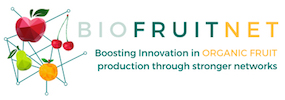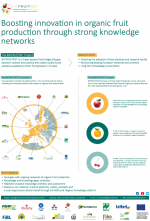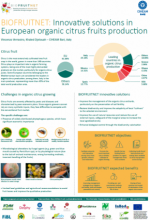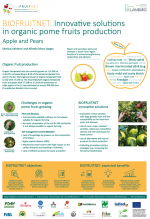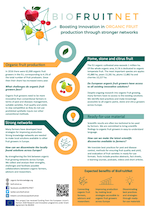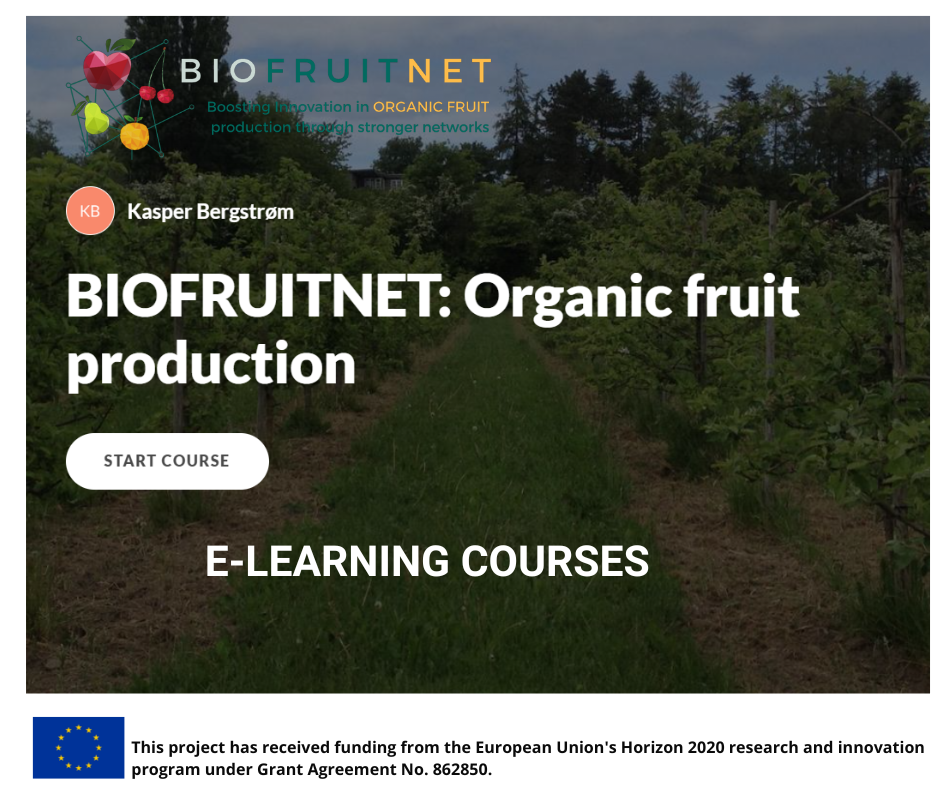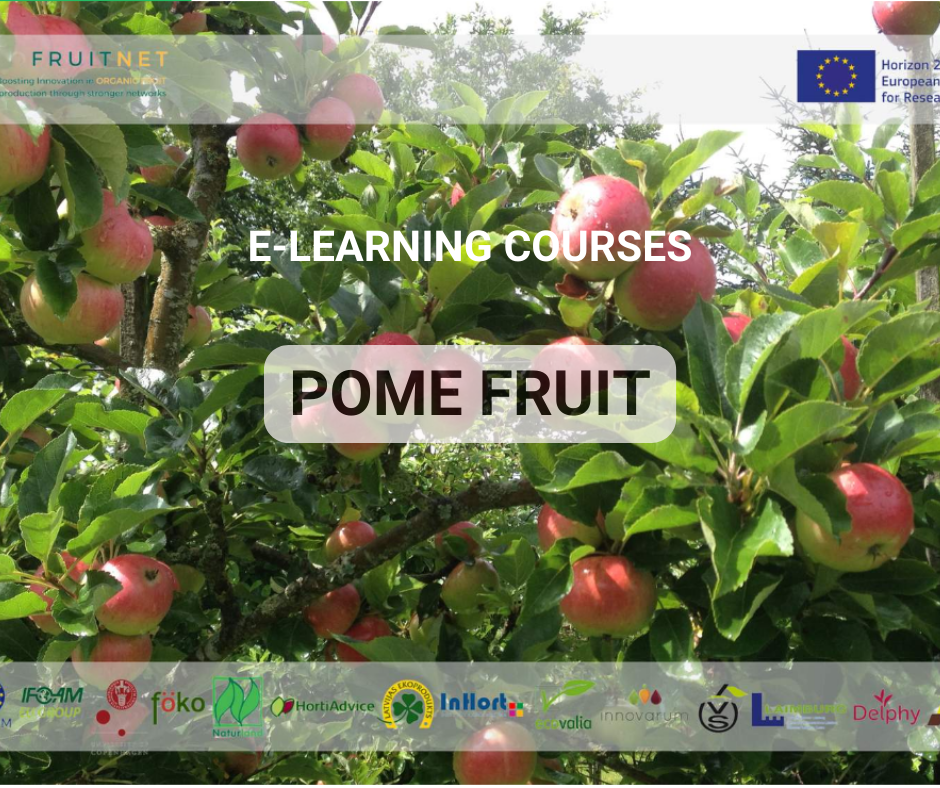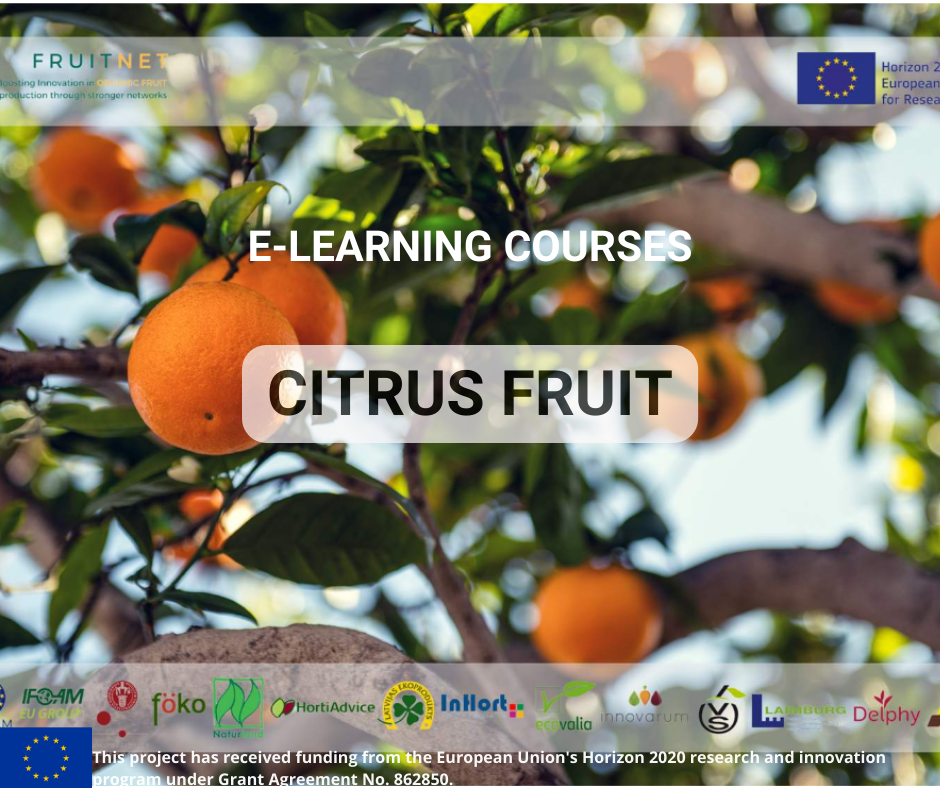PROJECT MID-TERM RESULTS
SURVEYS ON NEEDS, GAPS AND PRACTICES
A survey was conducted by BIOFRUITNET’ partners in order to identify the needs, the gaps and the practices in organic fruit production of pome fruits, stone fruits and citrus in Europe. The questionnaire was focused on plant health, functional biodiversity, soil and fertilization, varieties and rootstocks.
An online questionnaire was implemented in English, and national versions have been prepared for each country to facilitate the collection of information from respondents. The questionnaire was composed of one common part to all fruits species, and one part specific for each fruits species considered: apple, pear, apricot, peach, plum, cherry and orange.
From June to November 2021, 149 fruit growers and 100 technical advisors were surveyed in a total of 26 countries. 9 countries represent 80% of the respondents: Italy, France, Spain, Germany, Poland, Czech Republic, Austria, The Netherlands and Switzerland.

Graph: Origin of the respondents (%)
We collected 114 answers for apple, 44 for pear, 18 for plum, 10 for peach, 20 for cherry, 15 for apricot and 31 for orange.
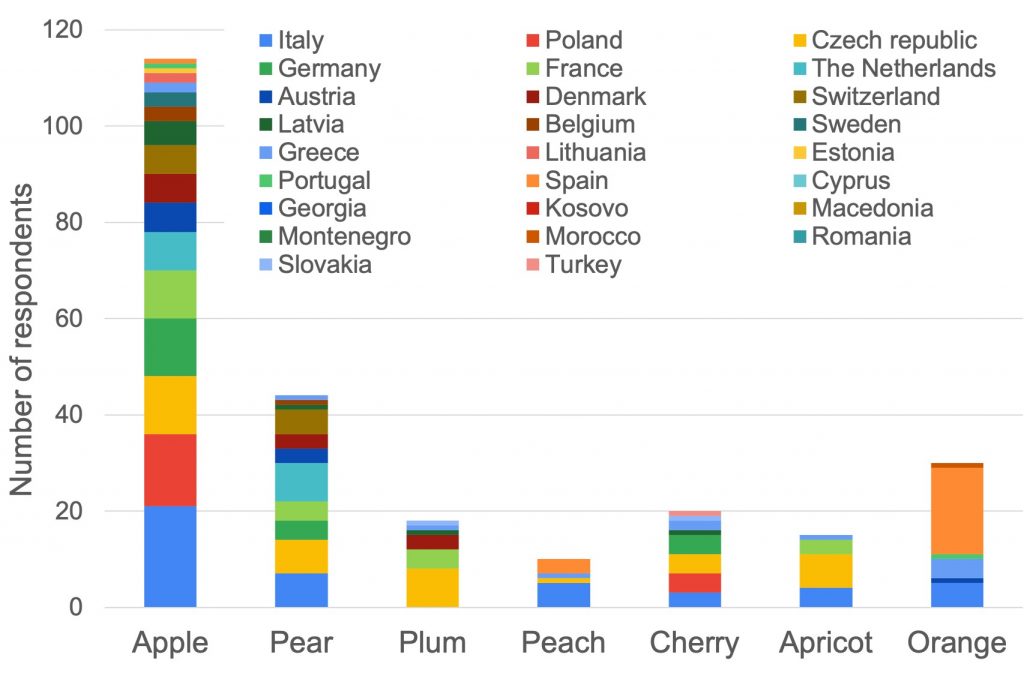
Table: Number of responses obtained for the 7 questionnaires dealing with a specific fruit species
The experience in organic fruit production for the farmers and advisors surveyed range respectively from 6 to 21 years and from 8 to 20 years. 79% of the farmers surveyed have 100% of their orchard grown in organic. The mean level of experience of the farmers surveyed seems high, in view of the current dynamics of the development of organic fruit production. The ‘organic part’ of the consultants represents 35 to 80% of their consulting activity.
Concerning fruit growers’ respondents, the median surface area of apple range from 1 and 30ha according to countries. For pear, the median surface area ranges from 1 to 7ha. For stone fruits, it ranges from 1 to 10ha with a high level of variability: from less than 1ha (e.g. Apricot in Austria and Switzerland, Peach in Poland) to 50ha (e.g. Peach in Spain) in farms. For citrus fruits, mainly orange, median surface area range from 2 to 15ha.
Concerning advisors’ respondents, The fruit-growing areas covered vary greatly depending on the country and the fruit species: from a few hectares to 1500ha. The few very high values, above 500ha, are observed for apples (fresh and processing), apricots, cherries (fresh and processing).
What media do you search for technical information?
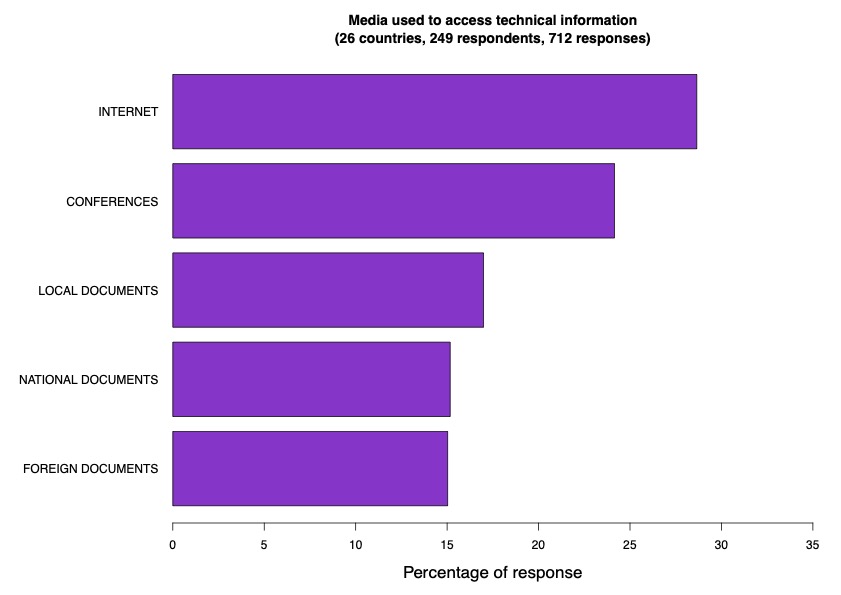
Among the media used to search for technical information, Internet is the most preferred tool, followed by conferences or documents in paper format. The written press in a foreign language is the least popular. The differences between countries provide interesting signposts: in countries where ‘Foreign documents’ represent less than 10% (Spain, Latvia, The Netherlands, Poland, Portugal, Sweden, Turkey), particular attention must be paid to the translation and/or accessibility of the documents produced, for example.
What are important interactive ways to get technical information?

Among the interactive ways of getting technical information, the exchange with an advisor or technician is the most frequent, followed by the exchange between farmers, open-field-days and meeting, and training. Social media are the less mentioned. These results show that the Biofruitnet project will have to carefully consider the target audience of advisors and technicians to enhance the dissemination.
What is your need for technical information?
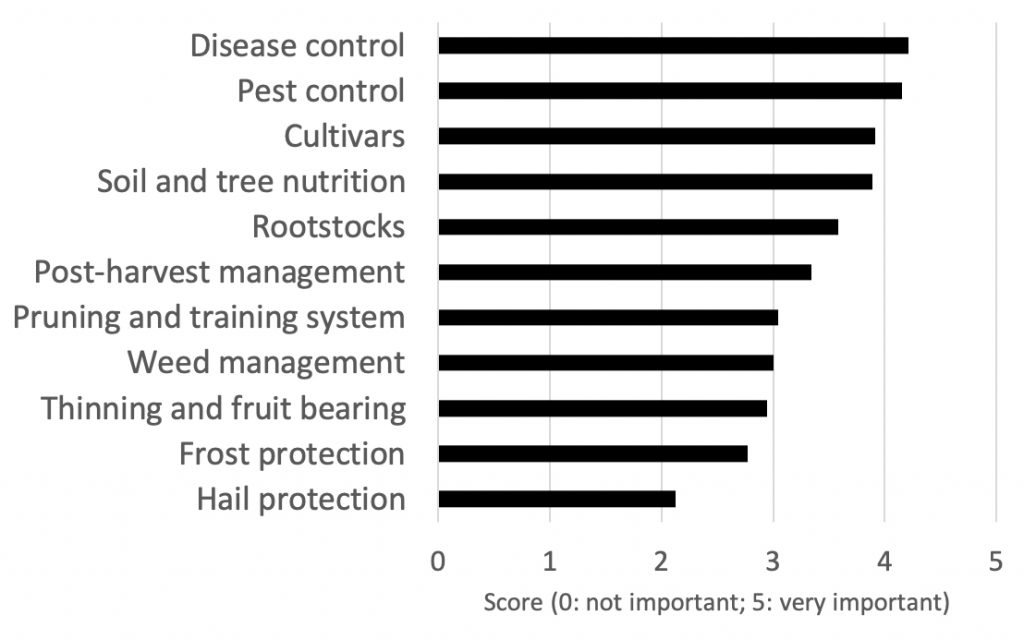
The four topics mentioned as being of greatest concern are disease and pest control, knowledge of varieties and tree and soil nutrition. These topics also appear to be the most important for each fruit species. One small exception is “rootstock”, which appears among the four priority themes for peaches. It should be noted that no answer has an average score of less than 2: as expected, all topics must be well known to successfully manage an orchard!
STONE FRUITS
Data for apricot, peach, plum and cherry were collected from 15, 11, 18 and 20 respondents respectively. The interpretation of the following results should therefore be treated with caution due to the limited sampling for each fruit species.
Which pests are relevant, i.e. currently managed by practices, or not managed but commercially threatening the stone fruits production?
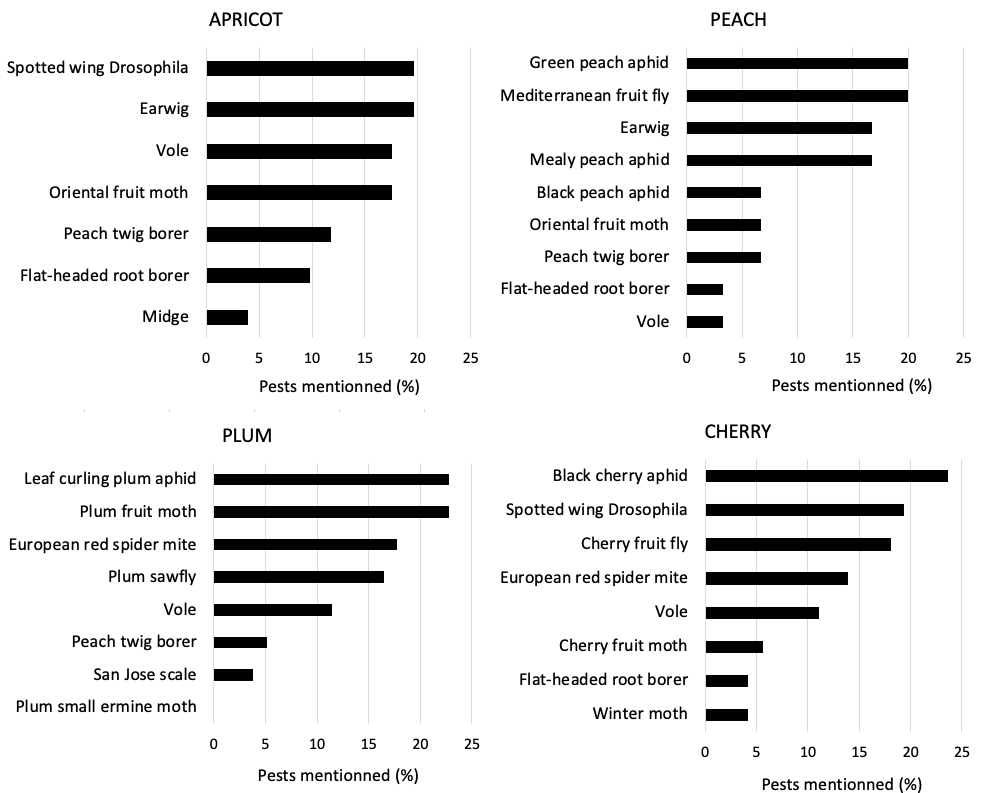
Between 7 and 9 pests per fruit species were mentioned as relevant by the respondents. Among the most mentioned pests for stone fruits were spotted wing Drosophila (apricot, cherry), earwig (apricot, peach) and different aphid species (except for apricot). Voles were mentioned at varying levels depending on the fruit species. The flat-headed root borer (Capnodis sp.) was mentioned for the three species where it can be a problem (apricot, peach and cherry) but at a rather low level.
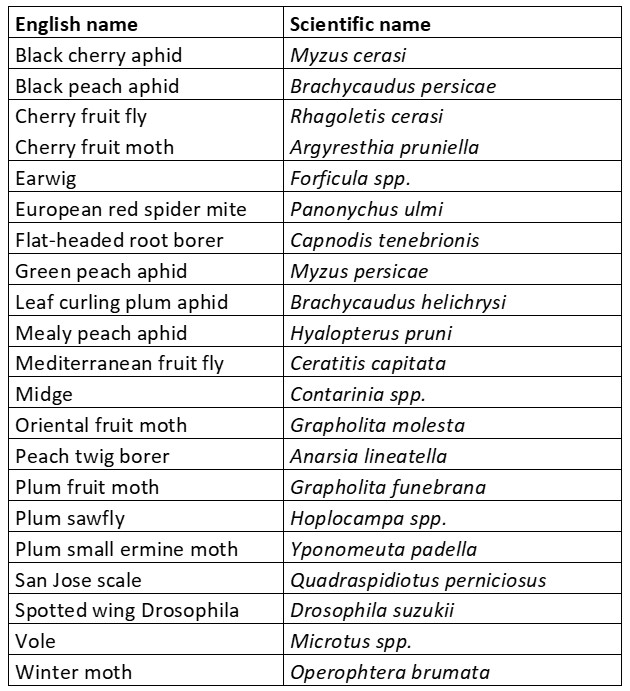
Which pests are relevant, i.e. currently managed by practices, or not managed but commercially threatening the stone fruits production?
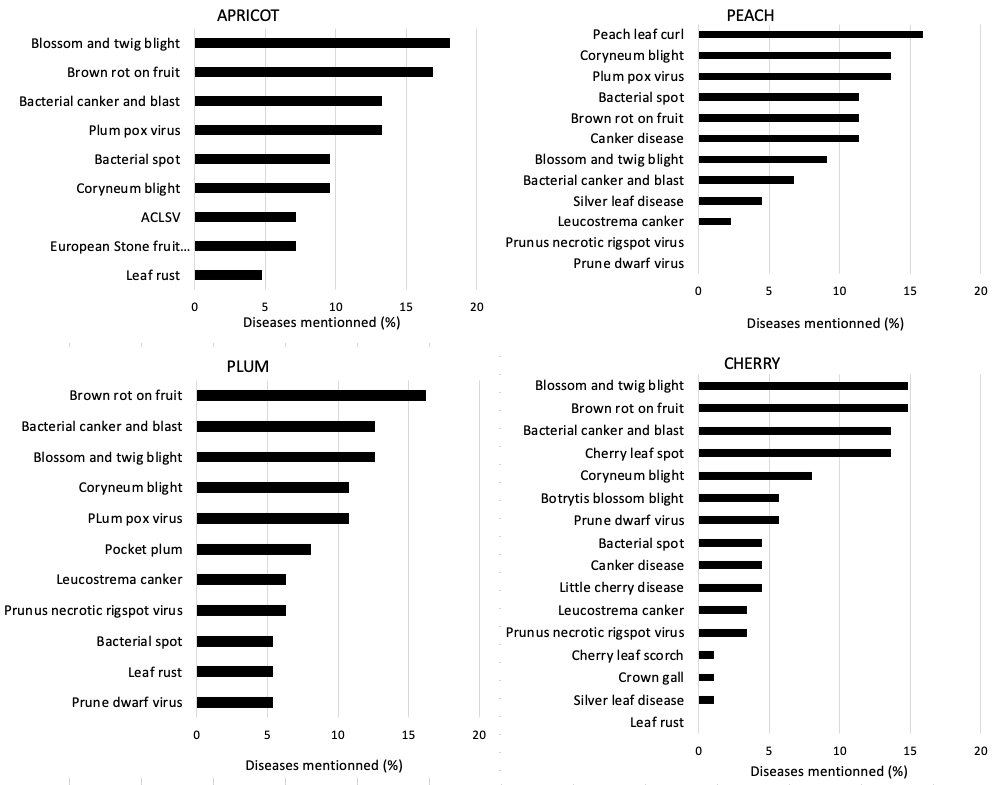
Between 8 and 15 diseases per fruit species were mentioned as relevant by the respondents. Among the diseases most mentioned for the 4 stone fruit species were Monilia spp. on blossoms, twigs and fruits. Bacterial canker diseases are also among the most occurrent diseases of concern. Virus diseases, especially plum pox virus (Sharka virus), were mentioned on apricot, peach and plum. Leaf rust was mentioned for the three species where it can be a problem (apricot, plum, cherry) at a limited proportion.
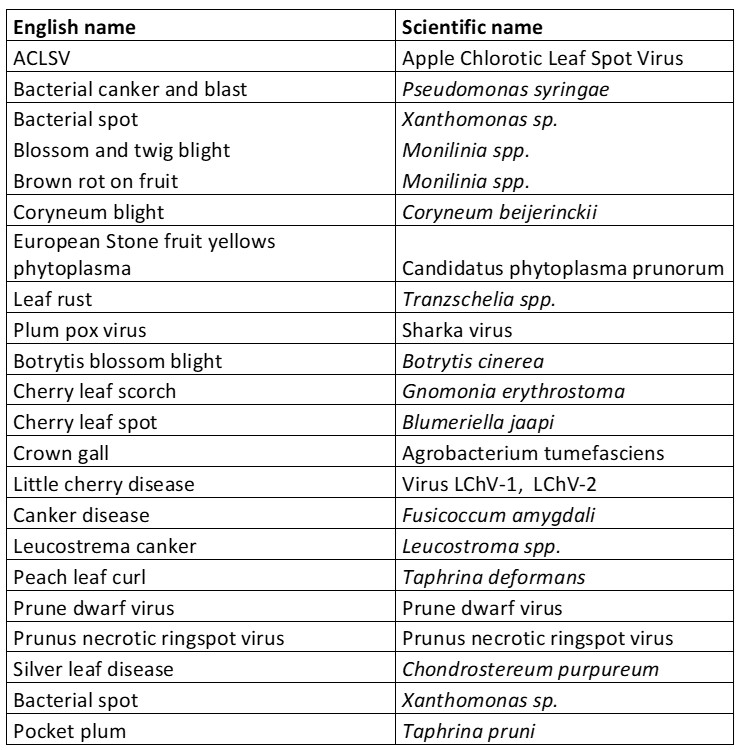
What is the dynamic of these pests in yours stone fruits orchards?
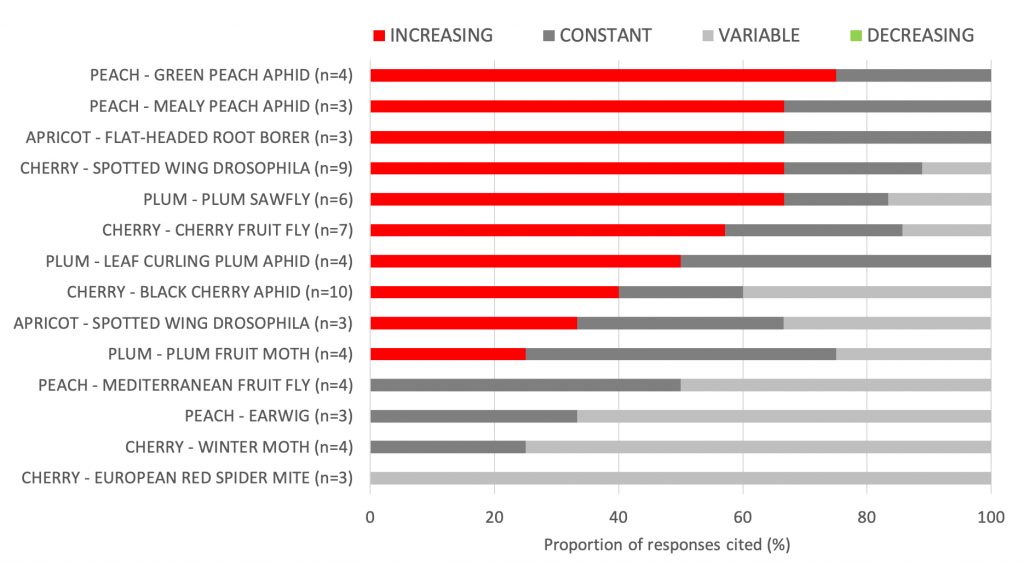
The graphic represents the proportion of responses obtained for each pest. Note: a constant pressure can be both low and high. “n” indicates the number of respondents for a given pest or disease. Only pests with at least 3 responses were considered. Most of the pests mentioned were seen as increasing or constant. Aphids and flies are an important part of the increasing pests. While the increasing pressure in spotted wing Drosophila is well documented, it is less known concerning other flies such as plum sawfly.
What is the dynamic of these diseases in yours stone fruits orchards?
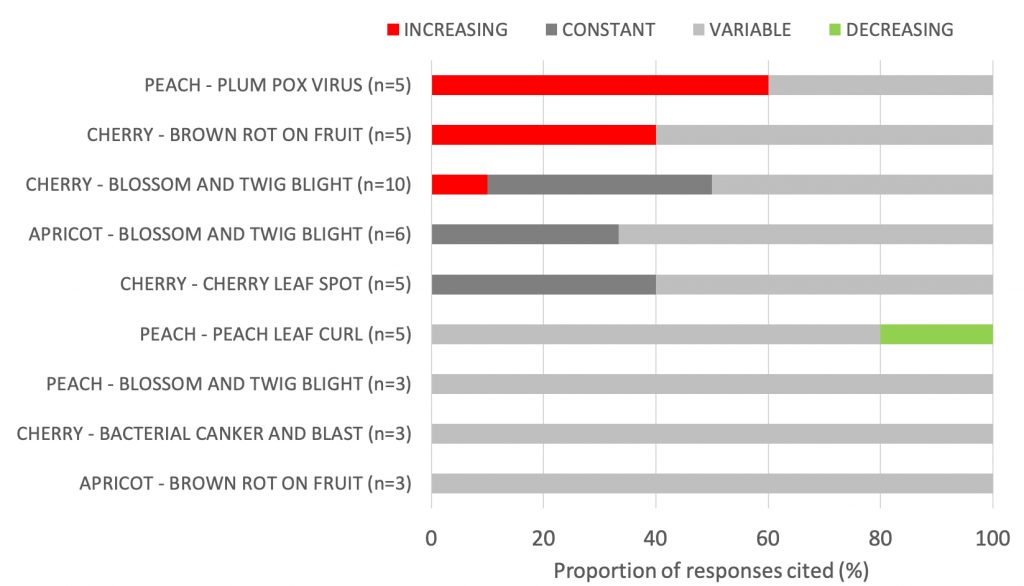
The disease status in stone fruits appears to be mostly variable over time. Plum pox virus being a quarantine disease, the increase of its pressure in orchards is a worrying signal.
How important are the following criteria when planting a new cultivar for stone fruits?

The 64 growers and technical advisors surveyed were asked to rate the importance of criteria for the development and selection of stone fruits cultivars. All the criteria proposed in the questionnaire were considered important since they all obtained an average score of more than 3.5. For the four stone fruits, the most important criteria were fruit quality, pest and disease susceptibility and alternate bearing behaviour. For Apricot, autofertility was mentioned as an important trait.
How important are the following criteria when choosing a new rootstock for stone fruits?

For rootstocks, the 8 criteria proposed were ranked in the same order whatever the stone fruits species considered. As expected, vigour control remains the first priority. Surprisingly, variation of production was mentioned as one of the most important criteria while some species (plum) are naturally more subject to alternate bearing behaviour than others (apricot, peach). Having rootstocks adapted to the future climate appears to be a major criteria.
CITRUS
Data for citrus were collected from 31 respondents in 6 countries. The interpretation of the following results should therefore be treated with caution due to the limited answer. We received 28 responses for orange and 3 for lemon. Due to the similarities between the pests and diseases of these two fruit species, the data have been merged for this topic.
Which pests and diseases are relevant, i.e. currently managed by practices, or not managed but commercially threatening the citrus production?
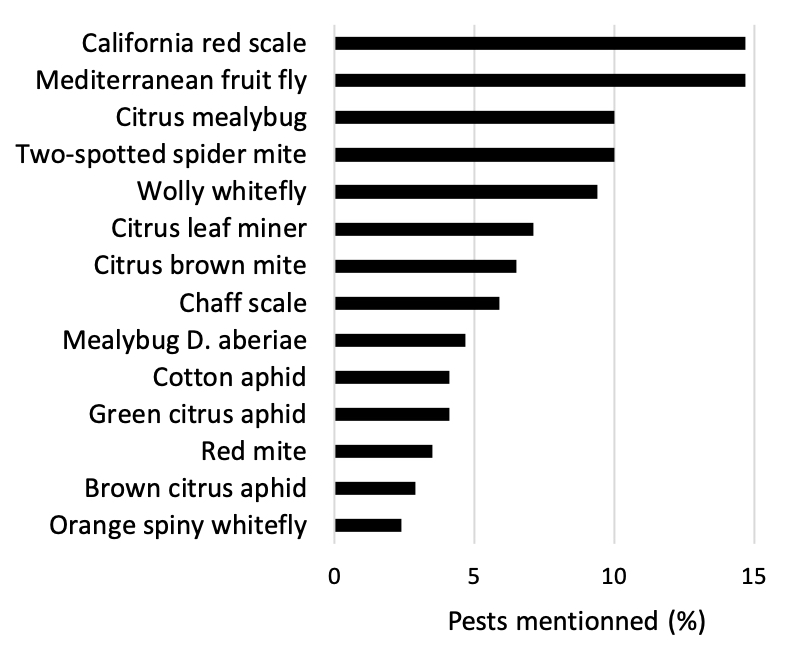
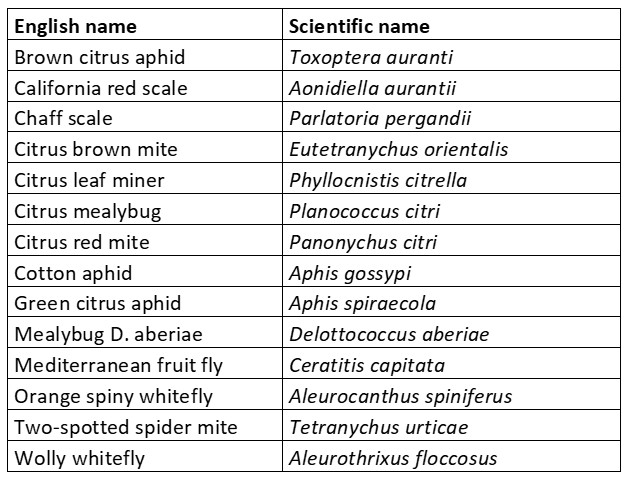

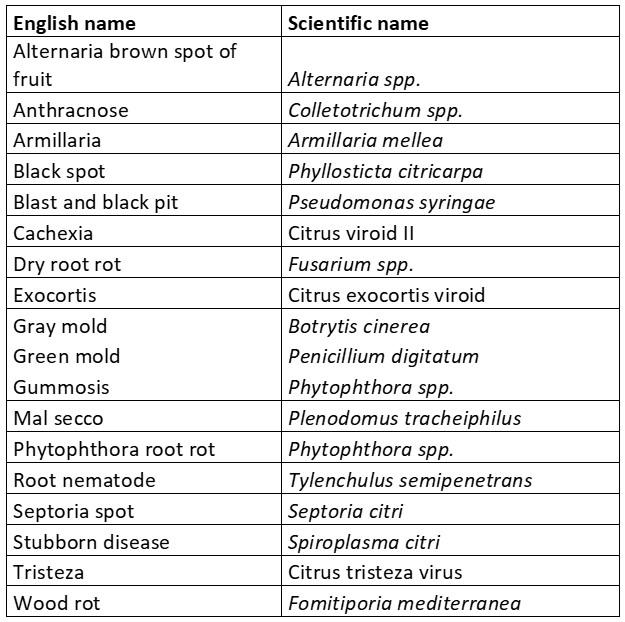
The respondents to this questionnaire highlighted the difficulties encountered to control some pests and diseases as the Californian red scale, the Mediterranean fruit fly, the Citrus mealybug and the two-spotted mite as pests. Concerning disease control, the most problematic one is Phytophthora, following by Gummosis, Tristeza and Gray mold.
What is the dynamic of these pests and diseases in your citrus orchards?
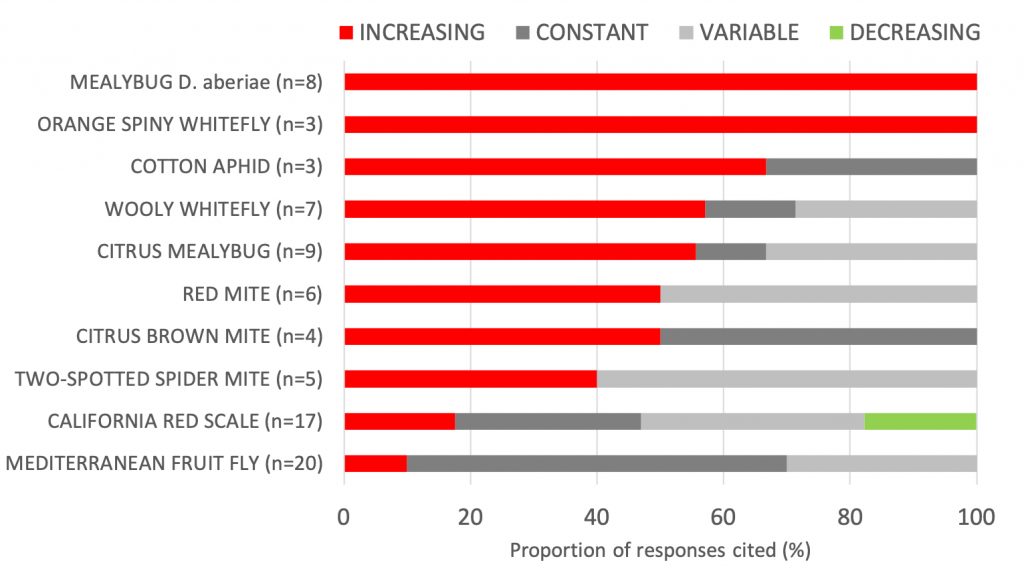
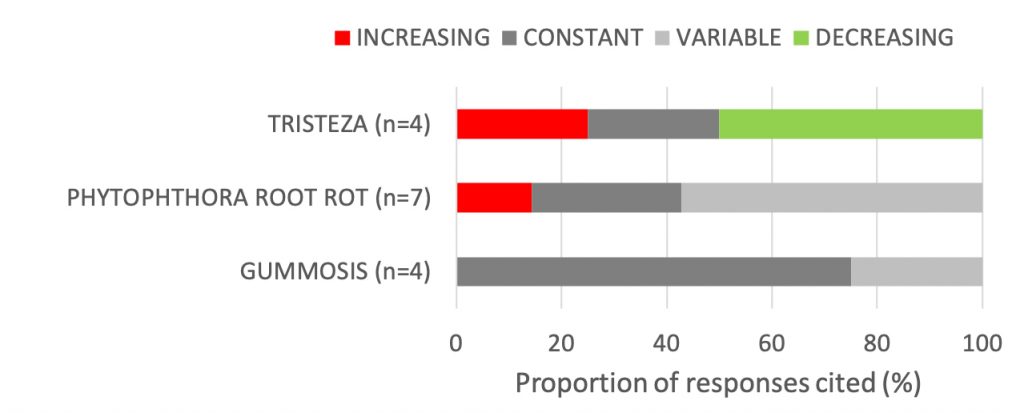
The respondents evidenced particular concerns about the new invasive pests who are seriously threatening the organic citrus production in the Euro-Mediterranean area. In this context, particular emphasis was given to the mealybug Delottococcus aberiae in Spain, the orange spiny whitefly in Italy and Greece, and the Brown citrus aphid in Spain and Portugal. Considering the lack of knowledge on these insect cycles and ecological behavior, technical information for the different control measures is highly requested by the farmers/advisors.
How important are the following criteria when planting a new cultivar or rootstock for orange?

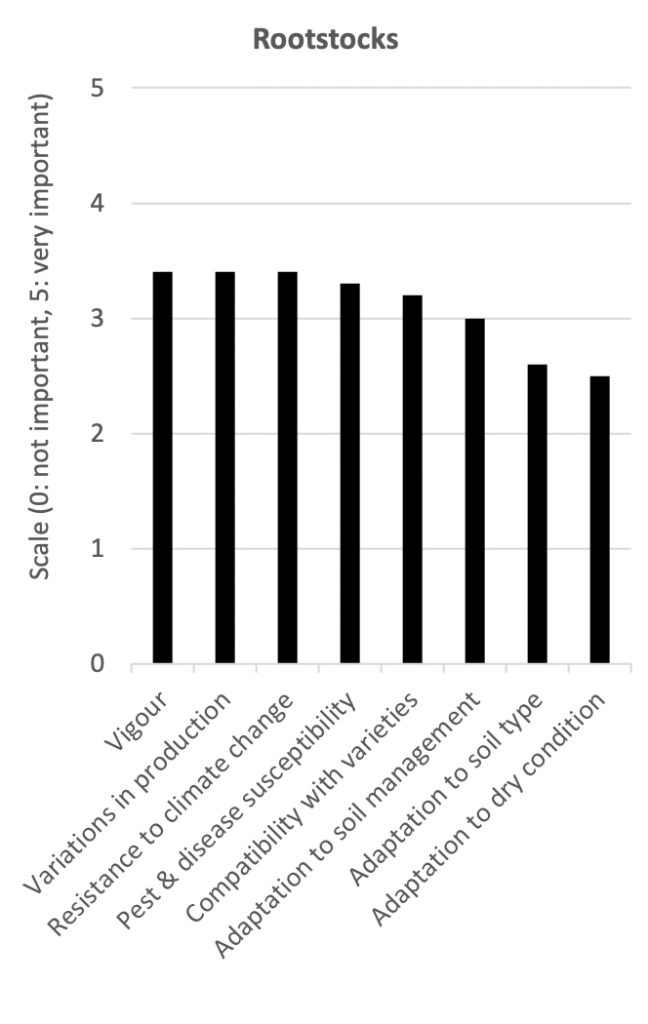
The most important criteria to choose an orange cultivar were fruit quality, harvesting period and alternate bearing behaviour. In contrast to pome and stone fruits, pest and disease susceptibility was mentioned as the less important. For rootstocks, the three main criteria mentioned were the vigour, variations in production and resistance to climate change, at a same level of importance.
Pome fruits results
Data for the apple and the pear were collected from 113 respondents in 18 countries, and 45 respondents in 11 countries, respectively.
Apple
Which pests and diseases are relevant, i.e. currently managed by practices, or not managed but commercially threatening the apple production?
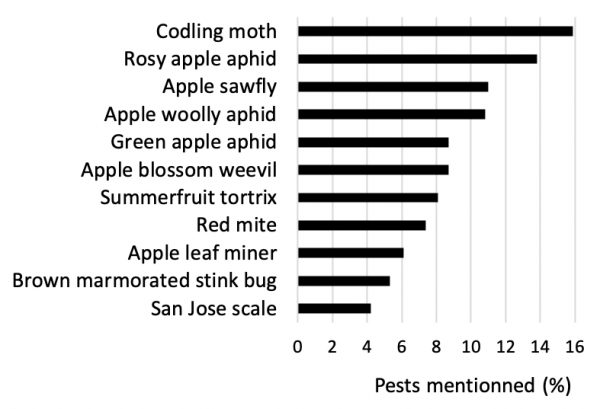
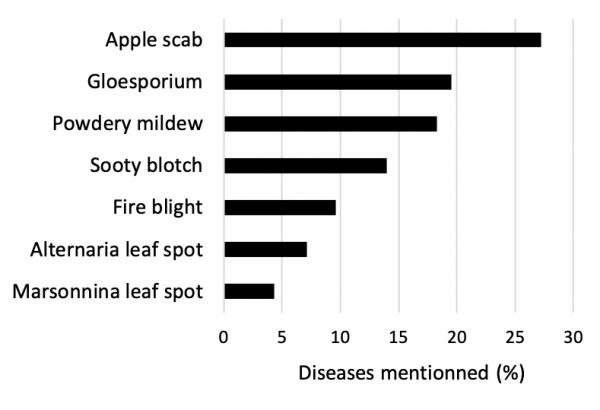
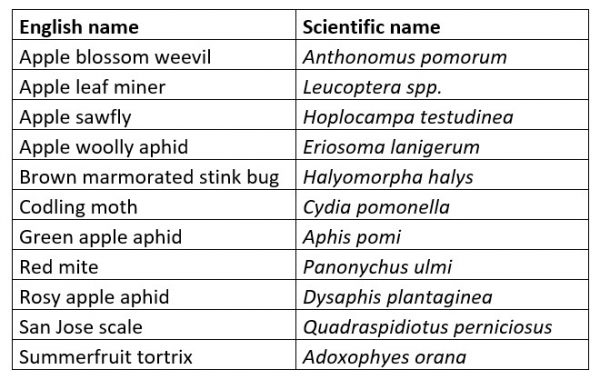

These results show a greater diversity of pests to be controlled than of diseases. The most frequently mentioned pests of European apple orchards are, not surprisingly, codling moth, followed by the rosy apple aphid. Together with apple sawfly and apple woolly aphid, these four pests represent more than 50% of the responses.
Among the diseases, apple scab is the most worrying for about a third of the fruit growers and technical advisors, followed by powdery mildew and two post-harvest diseases.
What is the dynamic of these pests and diseases in your apple orchards?
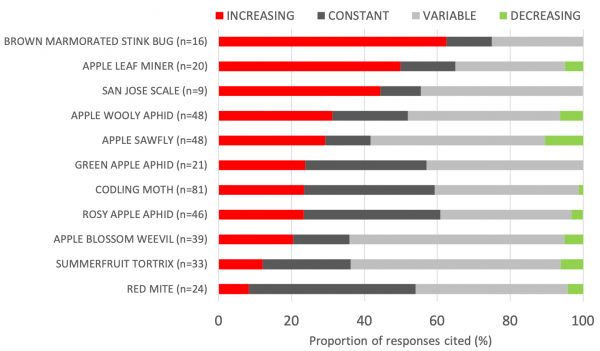

The perception of the fruit growers and technical advisors regarding the evolution of apple pest pressure in recent years was collected. The graphs represent the proportion of responses obtained for each pest and disease. Note: a constant pressure can be both low and high. “n” indicates the number of respondents for a given pest or disease.
Brown marmorated stink bug, apple leaf miner and San Jose scale are mostly perceived as having an increasing pressure. The pressure of apple blossom weevil, summerfruit tortrix apple woolly aphid and apple sawfly was perceived by the majority as variable from one year to the next. The pests that are perceived as “increasing” and “constant” are also those that are mentioned as being the most worrying: codling moth, rosy apple aphid, green apple aphid.
What are the most important characteristics when planting new cultivar or rootstock for apple?


The 113 growers and technical advisors surveyed were asked to rate the importance of criteria for the cultivation of apple varieties and rootstocks. All criteria proposed in the questionnaire were considered important since they all obtained an average score of more than 3.5. For the varieties, fruit quality was the first criterion, followed by susceptibility to pests and diseases. Adaptation or tolerance to climate change is rated higher for the rootstock, which suggests that this one is supposed to better address this issue than variety.
Pear
Which pests and diseases are relevant, i.e. currently managed by practices, or not managed but commercially threatening the pear production?
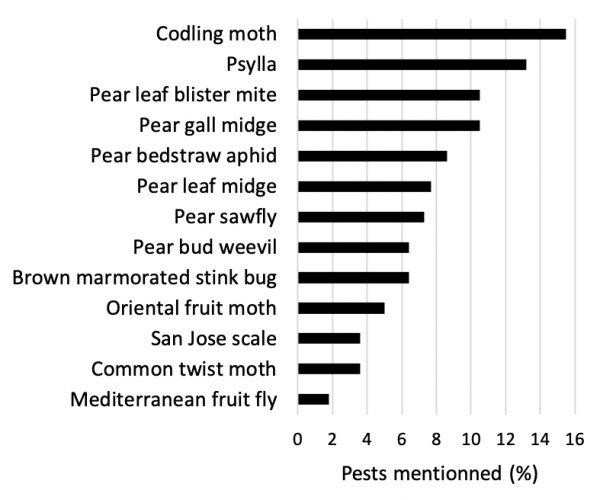

As for apple, we can see a greater diversity of pests than diseases that pear fruit growers have to deal with. The most frequently mentioned pests of pear orchards are codling moth, pear psylla and pear leaf blister mite. All pests mentioned in the questionnaire were mentioned once at least. Among the diseases, pear scab is the most worrying for a third of the fruit growers and technical advisors, followed by fire blight.
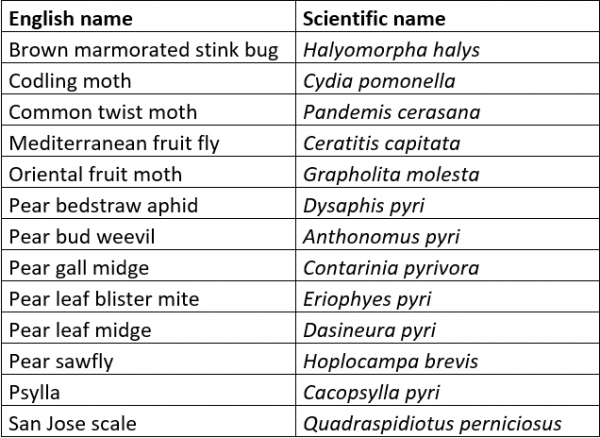

What is the dynamic of these pests and diseases in your pear orchards?

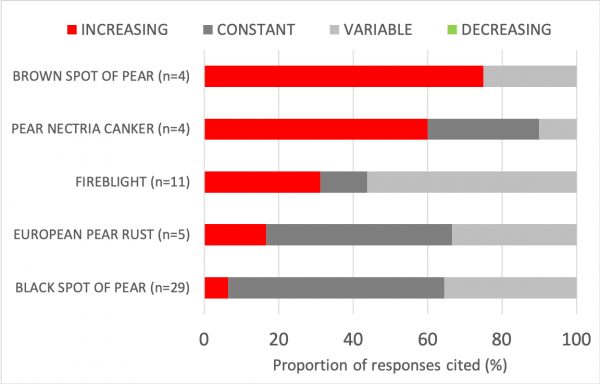
The perception of the fruit growers and technical advisors regarding the evolution of pear pest pressure in recent years was collected. The graphs represent the proportion of responses obtained for each pest. Note: a constant pressure can be both low and high. “n” indicates the number of respondents for a given pest or disease.
More than 60% of the respondents considered pear bud weevil, brown marmorated stink bug and pear sawfly to be increasing pests, and pear psylla to be variable according to years. Brown spot of pear and pear nectria canker are mostly considered as increasing diseases.
What are the most important characteristics when planting new cultivar or rootstock for pear?
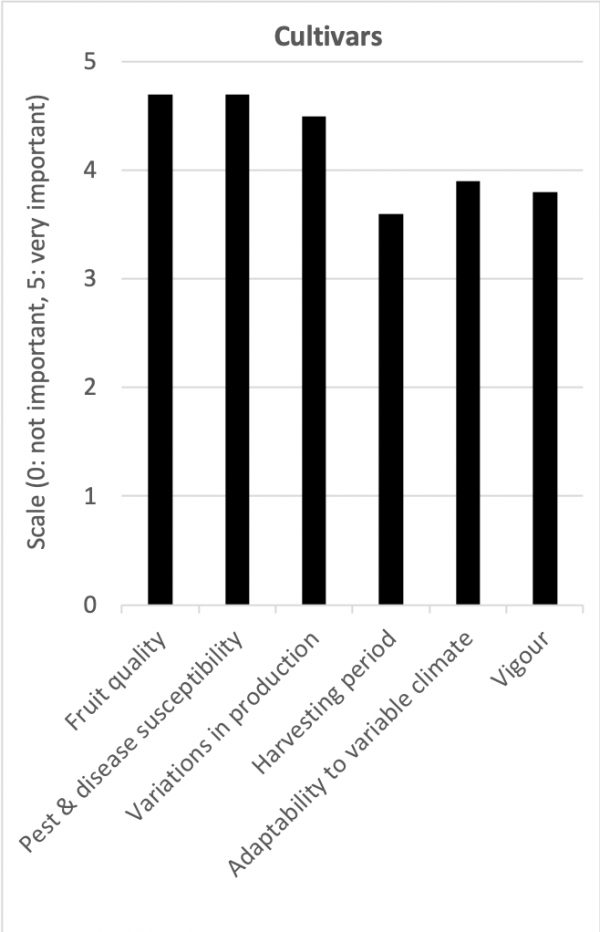
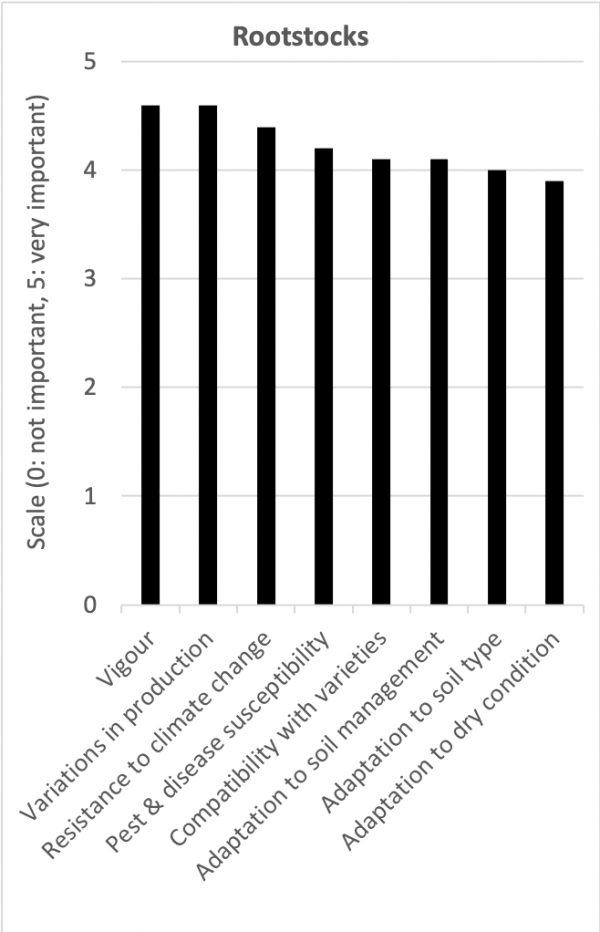
The 45 growers and technical advisors surveyed were asked to rate the importance of criteria for the cultivation of pear varieties and rootstocks. All criteria proposed in the questionnaire were considered important since they all obtained an average score of more than 3.5. The main important criteria to choose a cultivars are fruit quality, pest and disease susceptibility and alternate bearing behaviour. For rootstocks, all criteria appear to be of equal importance.
SCIENTIFC AND TECHNICAL KNOWLEDGE
In the project BIOFRUITNET, nine search strings covering stone fruits, pome fruits and citrus fruits, within the selected main topics: pests, plant diseases and plant nutrition were developed, to target the most relevant scientific literature within the topics.
The bibliographic searches were conducted on October 19, 2020 in Web of Science. The databases presented are the complete lists of references included from the WoS search. These lists will be processed to select the most relevant materials ready for practice in a following project work package.
Consult the list scientific articles on organic fruit growing in the following LINK .
PRACTICE ABSTRACTS
POME FRUIT
STONE FRUIT
CITRUS FRUIT
GENERAL CONTENT
E-LEARNING COURSES
Organic fruit production is expanding rapidly, and has a superior market value compared to conventional produce. It is also a challenging production system. Organic fruit production is especially challenged by losses to pest and diseases, and lack of information on management, suitable varieties, and rootstocks.
In the European wide project BIOFRUITNET, three e-learning courses covering pome fruit, stone fruit, and citrus fruit have been developed, with the aim to reach a wide range of learners, and provide the most recent knowledge within best practices of plant protection in fruit orchards. Each of the courses are addressing aspects of pest control, disease control, functional agrobiodiversity, and varieties and rootstocks.
The courses include various learning formats, such as slide show presentations, practice abstract, and quizzes. All teaching materials presented, can be downloaded and used for own teaching purposes.
Click on the image to access the course
This presentation describes five major pests in apple production, their symptoms and damage, and strategies for monitoring and control. A pdf file of the slides are available for download below the video (voiceover by Lauren Dietemann).
The course consists of four parts:
- Part 1 – Strategies for pest control
- Part 2 – Strategies for disease control
- Part 3 – Varieties and rootstocks
- Part 4 – Functional Agrobiodiversity
Click on the image to access the course
This course gives an overview of the challenges and tools for best practice plant protection in organic stone fruit production. The course is developed in the European wide project BIOFRUITNET(opens in a new tab).
The course consists of five parts:
- Part 1: Main pests and diseases in stone fruit
- Part 2: Strategies for pest control
- Part 3: Strategies for disease control
- Part 4: Varieties and rootstocks
- Part 5: Functional Agrobiodiversity (in pome and stone fruit production)
The course includes slide show presentations, practice abstracts, quizzes, and other. The course progresses by pressing ‘continue’ after each activity. In addition, educators can download materials for own teaching purposes.
Click on the image to access the course
This course gives an overview of the challenges and tools for best practice plant protection in organic citrus fruit production. The course is developed in the European wide project BIOFRUITNET .
The course consists of three parts:
- Part 1: Strategies for pest control
- Part 2: Emerging phytosanitary risks
- Part 3: Functional Biodiversity
The course includes slide show presentations, practice abstracts, quizzes, and other. The course progresses by pressing ‘continue’ after each activity. In addition, educators can download materials for own teaching purposes.
Click on the image to access the course
PUBLICATIONS
European Knowledge networks in organic fruit production – Scientific publication
An Overview of Pest and Disease Occurrence in Organic Pome Fruit Orchards in Europe and on the Implementation of
Practices for Their Control – Scientific publicationMain Research needs in Organic Pome Fruit Growing – Short communication
Technical Needs in Organic Fruit Growing in Europe – Short communication
Boosting Innovation in Organic FRUIT production through strong knowledge NETworks – CORDIS article on BIOFRUITNET
